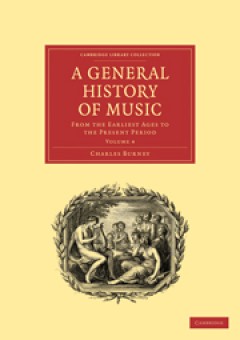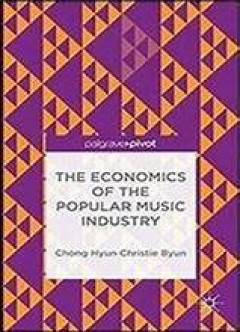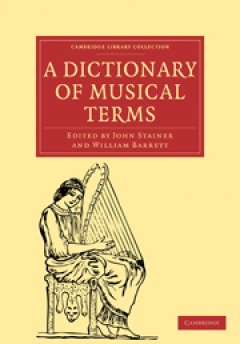Filter by

A General History of Music
Charles Burney (1726–1814), was the foremost music historian of his day. The General History, his most famous work, was published in four volumes between 1776 and 1789 and is still of great value today. Burney wanted to write something which would appeal to and inform the musician and the general reader. Research for the History was undertaken during two European tours, in 1770 and 1772, cons…
- Edition
- -
- ISBN/ISSN
- 9780511711206
- Collation
- -
- Series Title
- Cambridge Library Collection - Music
- Call Number
- -

A General History of Music
Charles Burney (1726–1814), was the foremost music historian of his day. The General History, his most famous work, was published in four volumes between 1776 and 1789 and is still of great value today. Burney wanted to write something which would appeal to and inform the musician and the general reader. Research for the History was undertaken during two European tours, in 1770 and 1772, cons…
- Edition
- -
- ISBN/ISSN
- 9780511711237
- Collation
- -
- Series Title
- Cambridge Library Collection - Music
- Call Number
- -

A General History of Music, from the Earliest Times to the Present
The writer, composer and organist Thomas Busby (1754–1838) is best remembered for his highly entertaining Concert Room and Orchestra Anecdotes (1825), which paints a vivid picture of musical life at the time. The son of a coach painter, Busby was originally articled to the composer Jonathan Battishill, but found the experience unrewarding. His compositions (many now lost) include songs, theat…
- Edition
- -
- ISBN/ISSN
- 9781139833745
- Collation
- -
- Series Title
- Cambridge Library Collection - Music
- Call Number
- -

A General History of Music, from the Earliest Times to the Present
The writer, composer and organist Thomas Busby (1754–1838) is best remembered for his highly entertaining Concert Room and Orchestra Anecdotes (1825), which paints a vivid picture of musical life at the time. The son of a coach painter, Busby was originally articled to the composer Jonathan Battishill, but found the experience unrewarding. His compositions (many now lost) include songs, theat…
- Edition
- -
- ISBN/ISSN
- 9781139833752
- Collation
- -
- Series Title
- Cambridge Library Collection - Music
- Call Number
- -

The Economics of the Popular Music Industry
This Palgrave Pivot uses modeling from microeconomic theory and industrial organization to demonstrate how consumers and producers have responded to major changes in the music industry. Byun examines the important role of technology in changing its structure, particularly as new methods of creating and accessing music prove to be a double-edged sword for creators and producers. An underlying th…
- Edition
- 1
- ISBN/ISSN
- 978-1-137-46705-8
- Collation
- VIII, 128
- Series Title
- -
- Call Number
- -

A Concise History of Music: From the Commencement of the Christian Era to the…
Henry George Bonavia Hunt (1847–1917) is best remembered as the founder of Trinity College of Music, London, which had grown out of the Church Choral Society he had established in 1872. A talented preacher and choirmaster, he also edited several popular journals, composed, and served as a lecturer in music history for the University of London between 1900 and 1906. This popular textbook, firs…
- Edition
- -
- ISBN/ISSN
- 9781107300644
- Collation
- -
- Series Title
- -
- Call Number
- -

A Dictionary of Musicians, from the Earliest Ages to the Present Time
The publisher John Sainsbury produced this two-volume biographical dictionary of musicians in 1824. The book, as he acknowledges on his title page, borrows from the previously published works of Choron and Fayolle (in French), Gerber (in German), Orloff (Russian, writing in French), and his two notable English predecessors, Dr Burney and Sir John Hawkings. It contains a 'summary of the history …
- Edition
- -
- ISBN/ISSN
- 9780511703225
- Collation
- -
- Series Title
- Cambridge Library Collection - Music
- Call Number
- -

A Dictionary of Musicians, from the Earliest Ages to the Present Time
The publisher John Sainsbury produced this two-volume biographical dictionary of musicians in 1824. The book, as he acknowledges on his title page, borrows from the previously published works of Choron and Fayolle (in French), Gerber (in German), Orloff (Russian, writing in French), and his two notable English predecessors, Dr Burney and Sir John Hawkings. It contains a 'summary of the history …
- Edition
- -
- ISBN/ISSN
- 9780511703232
- Collation
- -
- Series Title
- Cambridge Library Collection - Music
- Call Number
- -

A Dictionary of Musical Terms
This illustrated dictionary, written by the prolific Victorian composer Sir John Stainer (1840–1901) – best remembered today for his oratorio The Crucifixion – and W. A. Barrett, was first published by Novello in 1876. It provides definitions for 'the chief musical terms met with in scientific, theoretical, and practical treatises, and in the more common annotated programmes and newspaper…
- Edition
- -
- ISBN/ISSN
- 9780511693007
- Collation
- -
- Series Title
- Cambridge Library Collection - Music
- Call Number
- -

A Dictionary of Music and Musicians (A.D. 1450–1880)
This is a reissue of the first edition of George Grove's Dictionary of Music and Musicians, which has since evolved to become the largest and most authoritative work of its kind in English. The project grew in the making: the title page of Volume 1 (1879) refers to 'two volumes', but by the time Volume 4 appeared in 1889 there was also a 300-page appendix and a separate index volume. The dictio…
- Edition
- -
- ISBN/ISSN
- 9780511703300
- Collation
- -
- Series Title
- Cambridge Library Collection - Music
- Call Number
- -
 Computer Science, Information & General Works
Computer Science, Information & General Works  Philosophy & Psychology
Philosophy & Psychology  Religion
Religion  Social Sciences
Social Sciences  Language
Language  Pure Science
Pure Science  Applied Sciences
Applied Sciences  Art & Recreation
Art & Recreation  Literature
Literature  History & Geography
History & Geography